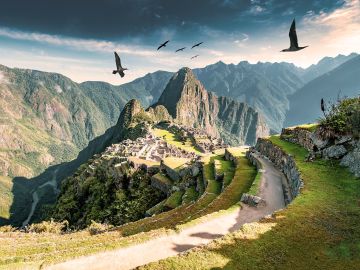
The Inca Trail – The Moonstone Trek Option, Peru
Itinerary
For those choosing the Moonstone Trek, the itinerary below replaces those days in the trip when the group walks the standard Inca Trail.
- For ‘The Inca Trail’ (code TPT) and ‘The Inca Trail in Comfort’ (code TPQ) these are days 4-7 of the Ex London itinerary (or days 3-6 of the land-only itinerary).
- For ‘Inca & Amazon Family Adventure’ (code FNP) these are days 5-8 of the Ex London itierary (or days 4-7 of the land only itierary).
- For ‘Inca Trail & Amazon Rainforest’ (code TPJ) these are days 8-11 of the Ex London itinerary (days 7-10 of the land-only itinerary).
- For ‘Peru Explorer’ (code APX) these are days 13-16.
- For ‘Inca Trail, Titicaca & Nazca’ (code TPD) these are days 8-11 of the Ex London itinerary (days 7-10 of the land only itinerary).
Start Day
An early start as it’s a very busy first day! We take a private minibus to the trailhead, stopping first to explore the nearby ruins from which the trek takes its name. This is a large site with several distinct Inca remnants, clearly of religious importance. As with the rest of the trek, we are most likely to have the site completely to ourselves. The Moonstone itself is a large carving on an enormous boulder, and its significance is not yet understood.
The trailhead is in a quiet, dusty valley and we soon climb high enough from the floor to enjoy some great views. At around lunchtime we stop to explore the imposing pre-Inca fortress of Wata that straddles the trail. The ruin has not yet been accurately dated and pottery can often still be found lying on the ground. The path then traverses along a green side valley as we make our way above a few tiny villages before entering the village of Chillipawa, where we camp.
Second Day
A long, steady climb with plenty of rest stops to aid acclimatisation takes us above the villages and into the high pampas – rugged meadows of long grass. We normally stop for lunch shortly before the crest of the Accoccosa Pass (and the very rare Andean Flicker is sometimes seen (although often heard!). The last leg of the pass is on loose red scree, but the view from the top makes it all worthwhile: a broad, hidden valley surrounded by snowy peaks – the Huayanay Range on the left, the Urubamba Range straight ahead and beautiful, triangular Mt Veronica (5,800m) to the right. We have time to explore this plateau and experience walking in the high altiplano before returning to our camp for a well-deserved hot dinner. The camp’s isolation, well away from any settlements, results in spectacular night skies when clear.
Third Day
We start after breakfast by following the stream from down this hidden valley into a narrow canyon. Rare polylepis trees grow here and we pass through a small grove as we leave the canyon. Our path then turns North and traverses very high above a deep and steep valley separating us from the Huayanay Mountains. This is probably the most spectacular section of the trek and we roughly follow a (now defunct) Inca aqueduct spectacularly carved out of the cliffs to take water from the hidden valley of our campsite to the Sacred Valley several miles away. At the end of the traverse we have a short but steep climb up to our lunch spot, a flat, ridge-top meadow facing straight across the Sacred Valley to the snowy Urubamba Range.
After lunch we walk down to Huayrapunku. Meaning “Gate of the Wind”, this is a ridge-top Inca shrine oriented to Mt Veronica, of which it has a simply incredible view. Finally a short walk brings us to our final campsite in amongst the granite stones of the Canchiqata Quarry. It was here that huge blocks were cut from the rose-coloured granite before being dragged down the mountainside and across the river to the Sun Temple at Ollantaytambo.
Fourth Day
Photographers are advised to wake up before dawn this morning, to watch the sun rise over the Sacred Valley from our campsite high above it. The sun’s first rays catching the glaciers of Mt Veronica certainly makes the effort more than worthwhile. This is our last day on the trek and we descend from the pampas down into the lush valley floor along the enormous stone ramps on which the Incas dragged the stones. We cross the river and explore the huge Sun Temple complex to see where the stones ended and what use they were put to. Our trek ends as we board the train to Aguas Calientes, where we join the rest of the group in Aguas Calientes (the town below Machi Picchu).
How do I request the Moonstone Trail over the Inca Trail?
Simply book onto any of our guaranteed Walking & Trekking departures that do the standard Inca Trail and put a note on your booking that you want the Moonstone Trek. One of our sales team will then be in contact to confirm your choice of route. If you are in any doubt, please call our sales team on 0845 863 9616.

Download the Moonstone Trek Trip Notes.
Altitude & Distance Chart
The Moonstone Trek

The Inca Trail
This chart is included for comparison purposes only and represents the normal Inca Trail route.

Moonstone Trek Adventure Holidays
The Adventure Begins Here
Get regular inspiration straight to your inbox from Exodus’ experts.


